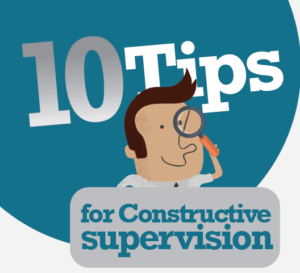This post is also available in:
 Spanish
Spanish
Social leaders often ask me “How do I supervise people without coming off as a ‘boss’?”. They wish to remain true to themselves while overseeing employee/volunteer progress. Here are my top 10 tips for constructive supervision.
Let organizational culture be your guide
As a leader, you are always conveying messages through your words and actions. Make sure your style fits with the culture of your organization. Organizational culture refers to your entity’s style and values. You can usually find these in your strategic plan or beliefs/philosophy statement (Example: Google). If, for example, collaboration is one of your entity’s core values, you should not be making unilateral decisions.
Make culture drive the recruiting of staff, volunteers and, very importantly, Board of Directors’ members. If your entity values inclusion, recruit diverse people. Lack of cultural alignment can sometimes prove more destructive than the absence of skills.
Finally, analyze your processes, the way you do things. Are they aligned? If one of your organization’s values is “efficiency”, nix bureaucratic paperwork.
Delegate effectively
You can’t do everything yourself, no matter how much you long to. So, become a master delegator! How?
- Set yourself up for success. Choose the right person for the right task. Take into account your team’s strengths and weaknesses.
- Clarify expectations, such as format, etc. Encourage questions.
- Negotiate the deadline. Don’t impose it.
- During the assignment, don’t hover! Give her space to manage her own time, without asking her for progress updates.
- After the task is done, acknowledge your delegate’s effort and provide concrete feedback for next time.
Delegating is really a teaching exercise. Approach it that way.
Play to your strengths
Perfectionists focus on their perceived shortcomings, thus not maximizing their potential. I guarantee, you have WAY more strengths than weaknesses. Become a more constructive supervisor, simply by taking advantage of the great things that make you YOU. If you are awesome at conversations, ask yourself: “What are 3 ways I can use conversation to be a more constructive supervisor?”
Use tracking tools
We are lucky enough to live in the app age. There is a cheap tool for practically everything. So, use a collaboration app and cut down on emails, meetings and follow ups. A few of my favorites: Trello, Slack, Basecamp and Asana.
Ask
Most people assume that what works for them works for others. Clearly, that is not the case. This misunderstanding leads to a lot of workplace friction. It probably keeps you pretty busy! So, ask and encourage others to ask you. Discuss with your team members your different styles and expectations.
- How does each of you like to work?
- How do you communicate best, both giving and receiving?
- What is important to each of you?
- What do you need from each other?
- How do you each handle difficult conversations?
- What is your approach to stress?
This week, observe your supervision style. Try incorporating some of these tips. And, please, let me know how it goes!
TO BE CONTINUED…
Check out part 2 of this article. Subscribe to receive the “10 Tips for Constructive Supervision” infographic.
Already a member? You will receive the 10 Tips for Constructive Supervision infographic via email.








3 Comments
Leave your reply.